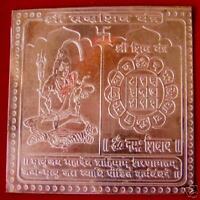
Shiva to mean "One who purifies everyone by the utterance of His name" or the Pure One. "the Auspicious One."He is the formless, timeless and spaceless, Supreme God of universe,time and everything.
Shiva is one of the gods of the Trinity. Shiva is married to the Goddess Parvati (Uma). Parvati represents Prakriti, which means perishable matter. Lord Shiva sits in a meditative pose on Mount Kailash against the white background of the snow-capped Himalayas. Lord Shiva not only represents the supreme state of perfection in man, but in his very pose indicates the way to reach it as well. The state of meditation shown in Shiva's posture is again symbolic. Meditation is the final gateway to Self-realization. On the auspicious occasion of Mahashivratri, Shiva performs the ecstatic dance of realization. Shiva is said to have a third eye known as gyana chakshu. Gyana chakshu literally means eye of wisdom. Shiva is also known as Gangadhara. which literally means, 'the carrier of Ganga' (river). Shiva is sometimes shown with his trident (trisula) in his hand. The trisula is a trident which symbolise's the destruction of the ego with its three-fold desires of the body, mind and intellect. Nataraja is Lord Shiva in the dance pose.He destroys evil and protects good. He bestows prosperity on worshipers although he is austere. He is omnipresent and resides in everyone as pure consciousness. One of his names is Bholenath, which means the innocent God. Lord shiva is Creator, destroyer and preserver of the universe.Shadding old habits generating new one and preserving the same. Shiva is often worshipped in an abstract manner, as God without form, in the form of linga.
Satyam,Shivam,Sunderam truth everything goodness and beauty, truth is everything and beautiful.Shiva is God of Yogis and stand for Kundalini Shakti energy.
Names and Meaning of Lord Shiva.
o Hara : The one who takes away Sorrow and pain.
o Mahadeva - The Supreme Lord : Maha = great, Deva = God
* Rudra The one who howls or strict and uncompromising
* Maheshwara The Supreme Lord: Maha = great, Eshwar = God
* Rameshwara - The one whom Ram worships: Ram, Eshwar = worships, God; Ram's God
* Mahayogi The Supreme Yogi: Maha = great, Yogi = one who practices Yoga
* Mahabaleshwara - God of Great Strength : Maha = great, Bal = strength, Eshwar = God
* Trinetra - Three-Eyed One, i.e. All-Knowing: Tri = three, Netra = Eye
* Triaksha - Three-Eyed One, i.e. All-Knowing: Tri = three, Aksha = Eye
* Trinayana- Three-Eyed One, i.e. All-Knowing: Tri = three, Nayana = Eye
* Tryambakam - Three-Eyed One, i.e. All-Knowing: Tri = three, Ambakam = Eye
* Mah?kala - Great Time, i.e. Conqueror of Time: Maha = three, Kala = Time
* Neelakantha - The one with a Blue Throat: Neel = blue, Kantha = throat
* Digambara - One who has the skies as his clothes, i.e. The Naked One: Dik = Clothes, Ambara = Sky
* Shankara - Giver of Joy
* Shambhu - Abode of Joy
* Vyomkesha - The One who has the sky as his hair: Vyom = sky, Kesha =hair
* Chandrashekhara - The master of the Moon: Chandra = Moon, Shekhara = master
* Siddheshwara - The Perfect Lord
* Trishuldhari - He who holds the divine Trishul or Trident: Trishul = Trident, Dhari = He who holds
* Dakhshinamurthi - The Cosmic Tutor
* Kailashpati - Lord of Mount Kailash
* Pashupatinatha - Lord of all Creatures or Pashupati
* Umapati - The husband of Uma
* Gang?dhara - He who holds the river Ganga
* Bhairava - The Frightful One
* Sabesan - Lord who dances in the dais
* Nagaraja - King of snakes (Lord/Ruler/Controller of snakes)
* Ekambaranatha The destroyer of evil
* Tripurantaka The destroyer of the triplet fortresses Asuras.
* Ashutosh, easy to please God.
The 12 Jyotirlinga shrines or shrines of Shiva in the form of a Jyotirlingam are located at different parts of India of which southernmost is located at Rameswaram, while the northernmost is located in the snowy mountains of the Himalayas at Kedarnath:
* Somnatha located at Prabhas Patan in Saurashtra in Gujarat.
* Sree Shaila located at Sree Shaila near Kurnool enshrines Mallikarjuna .
* Ujjain ( Mahakaleshwar Jyotirlinga shrine )The ancient and historic city of Ujjain or Avanti in Madhya Pradesh is home to the Jyotirlinga shrine of Mahakaleshwar.
* Omkareshwar: Omkareshwar Jyotirlinga shrine and the Amareshwar temple is located on an island in the course of the river Narmada in Madhya.
* Kedarnath the Northernmost of the Jyotirlingas is located in the snow clad Himalayas.It is accessible only on foot, six months in a year.
* Varanasi The Vishwanath temple is located in Benares in Uttar Pradesh
* Bhimashankar Bhimashankar is located in the Sahyadri hills of Maharashtra, accessed from Pune.This is associated with the legend of Shiva destroying the demon Tripurasura.
* Tryambakeshwar This Jyotirlinga shrine located in Nasik in Maharashtra is associated with origin of the river Godavari.
* Vaidyanath temple at Deogarh in the Santal Parganas area of Bihar is considered as one of the 12 Jyotirlingas of Shiva.
* Nageshwar near Dwarka in Gujarat is one of the 12 Jyotirlinga shrines of Shiva.
* Rameswaram: This temple is located in the island of Rameswaram, in Southern Tamilnadu enshrines Ramalingeswarar, and is the southernmost of the 12 Jyotirlinga shrines of India.
* Grishneshwar Jyotirlinga Shrine is a temple located in the vicinity of the tourist town of Ellora.
“Om Namah Sivaya” is in truth both agama and veda. Namah sivaya represents all mantras and tantras. Namah sivaya is our souls, our bodies and possessions. Namah sivaya has become our sure protection."










